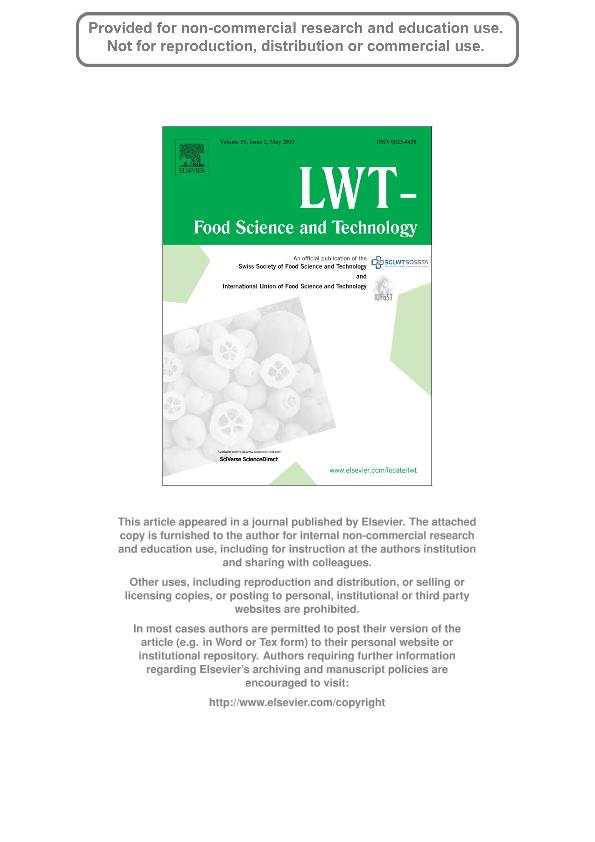Mostrar el registro sencillo del ítem
dc.contributor.author
Villarreal, Myriam Elizabeth

dc.contributor.author
Ribotta, Pablo Daniel

dc.contributor.author
Iturriaga, Laura Beatriz

dc.date.available
2017-09-22T22:25:19Z
dc.date.issued
2012-11
dc.identifier.citation
Villarreal, Myriam Elizabeth; Ribotta, Pablo Daniel; Iturriaga, Laura Beatriz; Comparing methods for extracting amaranthus starch and the properties of the isolated starches; Elsevier; LWT - Food Science and Technology; 51; 2; 11-2012; 441-447
dc.identifier.issn
0023-6438
dc.identifier.uri
http://hdl.handle.net/11336/25018
dc.description.abstract
Starch was isolated from Amaranthus cruentus whole grain (WG) and whole grain flour (WGF) using both the alkaline method (AM) and AM combined with food degree protease digestion (AMP). The methods involved successive soaking in NaOH solution (0.25 g/100 ml in AM and 0.05 g/100 ml in AMP), fibrous fraction wet milling, enzymatic hydrolysis in AMP and multi-staged centrifugation. Milling the amaranth grains in both methods increased significantly starch yield, recovery, and purity when compared against WG and lowered soaking times as well. Starch yield and recovery were 116.7% and 123.6% higher in WGF while protein, fiber, and ash contents showed decreases of about 44.4%, 34.8%, and 30.4% respectively. The effect of the extracting methods was less notorious than that of the grain milling. The results suggest that both methods are suitable for extracting starch from previously milled grains despite the fact that the AM shows significant operative advantages. The starches extracted showed conservative structure, A-type difractrometric patterns with high crystallinity degrees (∼39%) and Tg (gelatinization temperature) values (∼74 °C). These properties not present significant differences as a consequence of the extracting procedure used.
dc.format
application/pdf
dc.language.iso
eng
dc.publisher
Elsevier

dc.rights
info:eu-repo/semantics/openAccess
dc.rights.uri
https://creativecommons.org/licenses/by-nc-nd/2.5/ar/
dc.subject
Amaranth Starch
dc.subject
Isolation
dc.subject
Crystallinity
dc.subject
Microestructure
dc.subject.classification
Alimentos y Bebidas

dc.subject.classification
Otras Ingenierías y Tecnologías

dc.subject.classification
INGENIERÍAS Y TECNOLOGÍAS

dc.title
Comparing methods for extracting amaranthus starch and the properties of the isolated starches
dc.type
info:eu-repo/semantics/article
dc.type
info:ar-repo/semantics/artículo
dc.type
info:eu-repo/semantics/publishedVersion
dc.date.updated
2017-08-09T14:24:49Z
dc.journal.volume
51
dc.journal.number
2
dc.journal.pagination
441-447
dc.journal.pais
Países Bajos

dc.journal.ciudad
Amsterdam
dc.description.fil
Fil: Villarreal, Myriam Elizabeth. Universidad Nacional de Santiago del Estero. Facultad de Agronomia y Agroindustrias; Argentina. Consejo Nacional de Investigaciones Científicas y Técnicas; Argentina
dc.description.fil
Fil: Ribotta, Pablo Daniel. Universidad Nacional de Córdoba. Facultad de Ciencias Exactas, Físicas y Naturales; Argentina. Consejo Nacional de Investigaciones Científicas y Técnicas; Argentina
dc.description.fil
Fil: Iturriaga, Laura Beatriz. Universidad Nacional de Santiago del Estero. Facultad de Agronomia y Agroindustrias; Argentina. Consejo Nacional de Investigaciones Científicas y Técnicas; Argentina
dc.journal.title
LWT - Food Science and Technology

dc.relation.alternativeid
info:eu-repo/semantics/altIdentifier/doi/http://dx.doi.org/10.1016/j.lwt.2012.11.009
dc.relation.alternativeid
info:eu-repo/semantics/altIdentifier/url/http://www.sciencedirect.com/science/article/pii/S0023643812004574
Archivos asociados
